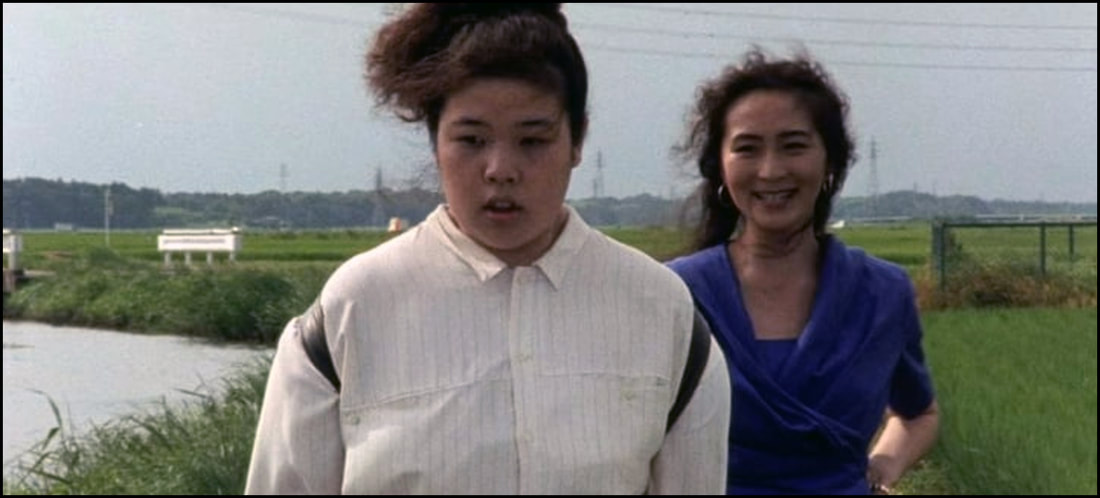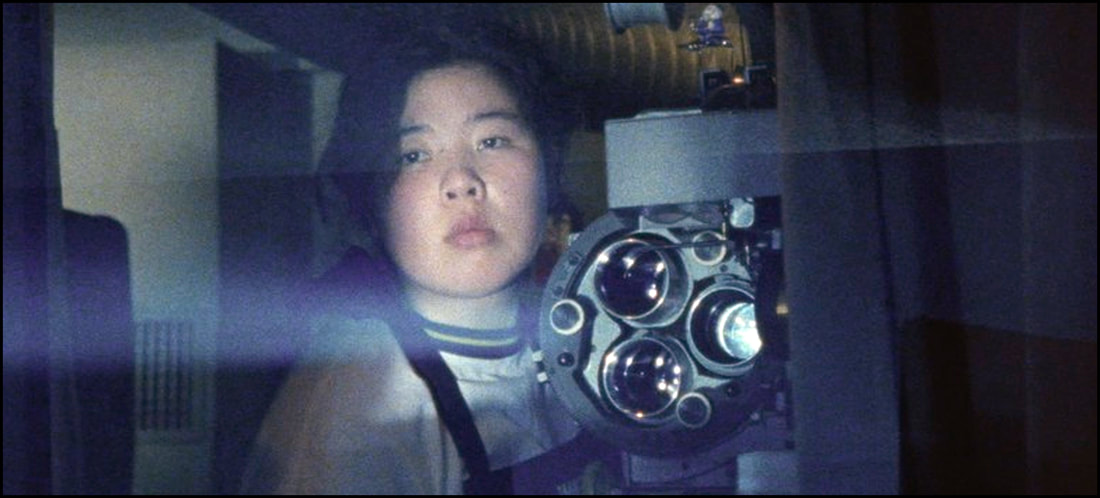Some of this is owed to the fact that I’m largely unaware of other nations’ cultural histories. It’s been my experience that the better Horror features – unlike other film genres – tend to be grounded in folklore unknown to me. While I can undoubtedly watch and appreciate a film’s visceral scares, I do – more than other viewers – prefer to be grounded in the knowledge of where these ideas originate, how their people think of them, and the way these factors interact within the context of a particular story. Still, J-Horror (Japanese haunts) have managed to bridge this divide far better than other countries – mostly owed to good translations – so I can say I’ve given more of their entries a screening than perhaps any other country’s library. Whenever I’ve been in doubt, I’ll do a little research, and that helps to give me a foundation with which to begin thinking about the tale the way I do.
And a little research was necessary after my viewing of Evil Dead Trap 2: Hideki (1992).
Now, don’t misunderstand me: this isn’t because I necessarily thought I missed anything. At its core, Evil Dead Trap 2 is a thrill ride – one layered with some very dark and bloody events all surrounding a pretty dour existence – and it functions efficiently on that level. Still, there are some elements intertwined within the screenplay involving mysticism, abortion, and the traditional roles of men and women that I thought may’ve meant more than they did at face value. In the end, I’m not certain they were intended for greater meaning; they may’ve been incorporated to give audiences just a little something extra to mull over once the credits rolled.
(NOTE: The following review will contain minor spoilers necessary solely for the discussion of plot and/or characters. If you’re the type of reader who prefers a review entirely spoiler-free, then I’d encourage you to skip down to the last few paragraphs for the final assessment. If, however, you’re accepting of a few modest hints at ‘things to come,’ then read on …)
“A female projectionist is haunted by the image of a small boy. Perhaps driven by insanity from a former abortion she goes on a killing spree, gutting women and removing their stomachs. Her relationship with her attractive and successful friend drives the plot deeper into insanity.”
Like love, we never truly know why we’re drawn into some of our friendships.
Some of these relationships make perfect sense. When we see another person who shares some of the same preferences and interests in life, then we establish a natural bond. As our tastes may change over time and experience, some of these pair-ups might fluctuate, either slipping away or perhaps even growing deeper. However, there are some friendships that work solely on ‘clicking.’ For reasons that may escape us, we simply feel better when we’re with that special someone. Though we may have little in common, we’re still almost magnetically drawn to one another, and it becomes just one more expression of who we are collectively instead of individually.
For the life of me, I can’t even begin to imagine what drew the characters of Emi and Aki into their relationship in Evil Dead Trap 2.
Emi (as played by Rie Kondoh) is the thin and attractive news anchor for the local television station. She’s got good looks, she’s got an assortment of equally charming friends, and the world – as they say – is at her fingertips. Aki (Shoko Nakajima) – by contrast – is a rather plump introvert who whiles away her life as a movie projectionist, seemingly only happy when she’s by herself and in dark places. But somehow writer/director Izo Hashimoto’s script would have us believe that these two found each other in high school, hit it off, and have been the best of friends ever since. They appear to have nothing in common. They don’t seem to even have any true open affinity for the other when in public. They just don’t look like the complement one another in the slightest. And, yet? Here we are.
Textually, that’s perfectly as Hideki – also the name of a small boy who shows up almost supernaturally during Aki’s darkest moments – is a study in opposites (to a degree). We spend the bulk of this journey alongside Aki, and – in that process – we do see her making attempts to transcend being ordinary. In her private moments, she longs for affection. When a possible romance appears on the horizon (in the guise of Emi’s philandering suitor Kurahashi), she’s smitten with its potential. But deep down in her soul, Aki is already so damaged that she’s taken to murdering prostitutes and then somewhat violently desecrating their bodies … an activity that, eventually, draws Emi into her inner circle: as the local newshound, she’s hellbent on exposing this evildoer. But, on that campaign, Emi becomes embroiled with a bloodlust all of her own, pitting these two opposites on course for an eventual showdown.
There’s a sprinkling of other elements that help Evil Dead Trap 2 feel like director Hashimoto may’ve been reaching for greater significance.
J-Horror was really just getting grounded in that nation, but Hideki – the phantom boy – is an inclusion that cries out for some explanation. At times, it appears that he’s the ghost of an aborted child in Aki’s youth, but later on there’s a suggestion that perhaps he stands for the maternal ‘want’ of a baby in order to feel complete. This confusion doesn’t serve the picture well, and maybe Hashimoto could’ve improved its eventual performance with audiences by being a tad more specific. As it’s left in the climax – Aki and Hideki stare into mutual oblivion – the possible connotation escapes me.
Also, there’s a bit of discussion involving Japanese mysticism. At one point in the film, Aki’s boss encourages her to try to find comfort in the throws of a religious group founded by his former wife; and – the dutiful employee – Aki goes to a meeting. During a treatment with prayer, she falls into a bit of a trance, producing spirit-induced scribbles that suggest her ties quite directly to the string of unsolved murders plaguing the big city. The psychic even senses the young woman’s latent ‘powers of suggestion’ alongside her own limited ability, a development that puts the two of them also at odds. Don’t worry: Aki’s dark side will fix that liability when the time is right.
Lastly, Hashimoto peppers his film with some interesting and occasionally dreamlike imagery. Aki strolls through the streets in an almost trancelike state, eventually carrying out her evil deeds. The curious little boy keeps showing up – in darkened theater audiences, in the background of Emi’s videotaped news segments, etc. Aki, Emi, and Kurahashi keep being drawn to meetings with one another – some planned, some seemingly random – and, though there’s little conflict, it’s clear that something more is going on inside their respective minds. Just what that is never becomes clear, weakening the foundation of the trinity in this story.
What’s sad is that – at face value – none of these hints truly seem to add up to anything other than serving as some visual and narrative trickery meant to heighten the atmosphere. Come the big finish when our two leading ladies are finally going mano-a-mano, the director infuses their faceoff with competing imagery: Emi’s ruthless choice of a boxcutter as a preferred weapon of choice versus Aki’s somewhat elegant film shears. It’s a clear contrast – one might think their selection should be reversed based on what we know of their respective personalities – but what am I to make of it? Is it subtext, or is the fact that they’re both dripping with blood all that matters?
Confusion aside, this Trap is still an impressive array of visuals, ones that just might keep you up at night. On that respect, Hashimoto’s probably very proud of himself.
Evil Dead Trap 2: Hideki is an almost dream-like affair. Reality seems to overlap with fantasy – in more ways than one – in this tale of two friends who find themselves curiously drawn closer in the bloodiest of pursuits. Still, the lack of any definitive explanation for precisely how all of this began, what the true nature of their relationship is, and where all of it supposedly went wrong makes the film feel vastly more like a cinematic exercise – maybe even somewhat experimental in nature – than it does a pure beginning-middle-end story. Don’t be mistaken: things to come to a bloody finish, but I’ve still let to know what to make of it all.
In the interests of fairness, I’m pleased to disclose that the fine folks at Unearthed Films provided me with complimentary streaming access to Evil Dead Trap 2: Hideki (1992) for the expressed purposes of completing this review; and their contribution to me in no way, shape, or form influenced my opinion of it.
-- EZ





 RSS Feed
RSS Feed